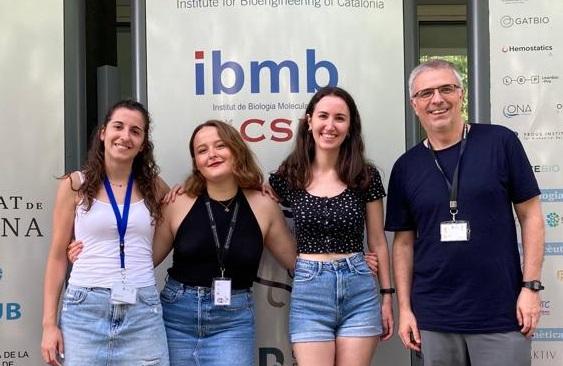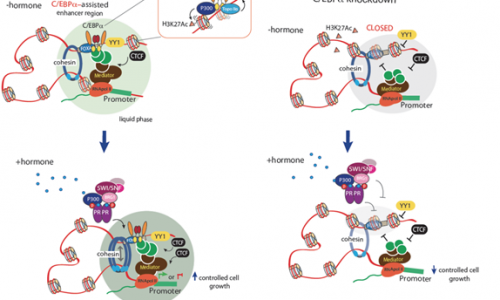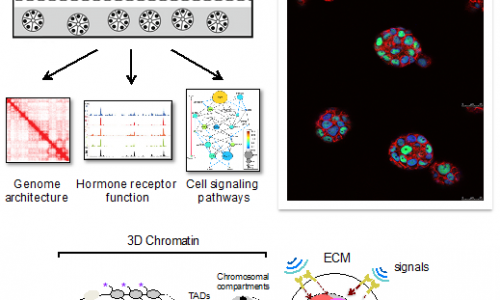Lab presentation
Many cancers are hormone-dependent and the main tools in the treatment of such tumors are based on the use of hormone antagonists or on drugs that affect its metabolism. Breast cancer (BC) is the result of an accumulation of a large number of mutations with 2.03 mutations/Mb according to the International Cancer Genome Consortium (ICGC) that, when assembled in a single breast cell, disrupt the cellular control system resulting in uncontrolled and autonomous erratic growth. Thus, thorough knowledge of the mechanisms of action involved will help in the development of new drugs that not only affect tumor growth but also avoid resistance to conventional treatments.
My Laboratory through global massive sequencing techniques, mass spectrometry and molecular cell biology approaches tries to elucidate the mechanistic basis of hormone-dependent tumor proliferation in BC.
Using cell lines and organoids that in the presence of estrogens and progestins proliferate and generate the expansion to stem cells (CD44high/CD24low) with a more aggressive phenotype and with a worse prognosis, we want to understand how the hormones act and generate such drastic changes in cell identity. We pay particular attention to the signaling pathways, kinases, long non-coding RNAs (lncRNAs), chromatin remodeling and DNA repair machineries that may be involved in the regulation of key genes involved in the process of cell dedifferentiation and cancer.
Our research investigation is focused on understanding the molecular mechanisms by which estrogens and progesterone induce cell proliferation in BC cells.

Projects
Research Lines:
- Characterization and targeting of oncogenic enhancers in BC
- Crosstalk between estrogen/progesterone hormonal response and novel signalling pathways associated with the regulation of chromatin structure and function
- Liquid phase condensates in BC
- Three-dimensional (3D) cultures as a more physiological approach to study hormonal function in BC
- How the organization of BC cells in organoids impacts on the cell nucleus, its 3D structure and its response to hormone
Lab people

Guillermo P. Vicent
Principal investigator
Guillermo Vicent obtained his PhD in Biological Sciences from the University of Buenos Aires. In 1998 he moved to the Institüt für Molekularbiologie und Tumorforschung (Marburg, Germany) as a postdoctoral fellow where he became interested in understanding the link between transcription and chromatin. In 2003 he moved to the Center for Genomic Regulation (Barcelona, Spain) where he developed his scientific career first as senior postdoc and then as staff scientist in the Gene Regulation, Stem Cells and Cancer Programme.
In 2018 he obtained a position as Scientific Researcher of the Spanish Research Council. Guillermo Vicent’s research is focused on elucidate the mechanistic basis of hormone-dependent tumor proliferation in breast cancer.
Using cell lines and spheroids that in the presence of estrogens and progestins proliferate and generate the expansion to stem cells with a more aggressive phenotype and with a worse prognosis, we will understand how the hormones participate and generate such drastic changes in cell identity. We pay particular attention to the cell signaling pathways, kinases, long non-coding RNAs (lncRNAs), chromatin remodeling and DNA repair machineries that may be involved in the regulation of key genes in the process of cell dedifferentiation and cancer.

Rosario Sanz

Marta Valverde

Judith Garcia
Past students
Diego Baranda
Martina Di Gisi
Selected publications
Julieta Ramírez-Cuéllar, Roberto Ferrari, Rosario T Sanz, Marta Valverde-Santiago, Judith García-García, A Silvina Nacht, David Castillo, Francois Le Dily, Maria Victoria Neguembor, Marco Malatesta, Sarah Bonnin, Marc A Marti-Renom, Miguel Beato and Guillermo P Vicent. LATS1 controls CTCF chromatin occupancy and hormonal response of 3D-grown breast cancer cells. EMBO J (2024). doi: 10.1038/s44318-024-00080-x
Pecci A, Ogara MF, Sanz RT and Vicent GP (2022) Choosing the right partner in hormone-dependent gene regulation: Glucocorticoid and progesterone receptors crosstalk in breast cancer cells. Front. Endocrinol. 13:1037177. doi: 10.3389/fendo.2022.1037177
Alejandro La Greca, Nicolás Bellora, François Le Dily, Rodrigo Jara, Ana Silvina Nacht, Javier Quilez, Jose Luis Villanueva, Enrique Vidal, Gabriela Merino, Cristóbal Fresno, Inti Tarifa Rieschle, Griselda Vallejo, Guillermo P. Vicent, Elmer Fernández, Miguel Beato, Patricia Saragüeta “Chromatin topology defines estradiol-primed progesterone receptor and PAX2 binding in endometrial cancer cells” eLife 2022;11:e66034 doi: 10.7554/eLife.66034
Amanda Garrido, Eunjeong Kim, Ana Teijeiro, Ajay Nair, Maria Matamala, Cristian Perna, Guillermo P. Vicent, Javier Muñoz, Ramon Campos-Olivas, Johannes Melms; Benjamin Izar; Robert Schwabe and Nabil Djouder “Histone acetylation of bile acid transporter genes plays a critical role in liver cirrhosis” Journal of Hepatology. 2021 Dec 24:S0168-8278(21)02294-7. doi: 10.1016/j.jhep.2021.12.019
Roser Zaurin Roberto Ferrari, A. Silvina Nacht, José Carbonell, Francois Le Dily, Jofre Font-Mateu, Lara Isabel de Llobet Cucalón, Enrique Vidal, Antonios Lioutas, Miguel Beato and Guillermo P. Vicent* “A set of accessible enhancers enables the initial response of breast cancer cells to physiological progestin concentrations” Nucleic Acids Research gkab1125, doi: 10.1093/nar/gkab1125 *Corresponding author
Rocha-Viegas L, Silbermins M, Ogara MF, Pellegrini JM, Nuñez SY, García VE, Vicent GP, Pecci A. “Glucocorticoids uncover a critical role for ASH2L on BCL-X expression regulation in leukemia cells” Biochimica et Biophysica Acta Gene Regulatory Mechanisms. 2020 Jan;1863(1):194475. doi: 10.1016/j.bbagrm.2019.194475
A. Silvina Nacht, Roberto Ferrari, Roser Zaurin, Valentina Scabia, José Carbonell, Francois Le Dily, Javier Quilez, Alexandra Leopoldi, Cathrin Brisken, Miguel Beato and Guillermo P. Vicent* “C/EBPa mediates the growth inhibitory effect of progestins on breast cancer cells” The EMBO Journal 2019 Sep 16; 38(18): e101426. doi: 10.15252/embj.2018101426 *Corresponding autor
María Ogara, Santiago Rodríguez-Seguí, Melisa Marini, A. Silvina Nacht, Martin Stortz, Valeria Levi, Diego Presman, Guillermo P. Vicent* and Adali Pecci* “The glucocorticoid receptor interferes with progesterone receptor-dependent genomic regulation in breast cancer cells” Nucleic Acids Research 2019 Nov 18;47(20):10645-10661. doi: 10.1093/nar/gkz857 *Corresponding authors.
Roni H. G. Wright, Antonios Lioutas, Francois Le Dily, Daniel Soronellas, Andy Pohl, Jaume Bonet, A. S. Nacht, Sara Samino, Jofre Font-Mateu, Guillermo P. Vicent, Michael Wierer, Miriam A. Trabado, Constanze Schelhorn, Carlo Carolis, Maria J. Macias, Oscar Yanes, Baldo Oliva and Miguel Beato “ADP-ribose derived nuclear ATP synthesis by NUDIX5 is required for chromatin remodeling and hormonal gene regulation” Science 2016 Jun 3; 352(6290): 1221-5. doi: 10.1126/science.aad9335
A. Silvina Nacht, Andy Pohl, Roser Zaurin, Daniel Soronellas, Priyanka Sharma, Roni H. Wright, Miguel Beato and Guillermo P. Vicent* “Hormone induced repression of genes requires BRG1-mediated H1.2 deposition at target promoters” The EMBO Journal 2016 Jul 7. pii: e201593260. doi: 10.15252/embj.201593260 *Corresponding autor
Gavin Whissell, Elisa Montagni, Paola Martinelli, Xavier Hernando-Momblona, Marta Sevillano, Peter Jung, Carme Cortina, Alexandre Calon, Anna Abuli, Antoni Castells, Sergi Castellvi-Bel, A. Silvina Nacht, Elena Sancho, Camille S. Attolini, Guillermo P. Vicent, Francisco X. Real and Eduard Batlle “The transcription factor GATA6 allows self-renewal of colon adenoma stem cells by repressing BMP gene expression” Nature Cell Biology 2014 Jul; 16(7): 695-707. doi: 10.1038/ncb2992
Bruno Di Stefano, Jose Luis Sardina, Chris van Oevelen, Samuel Collombet, Eric M. Kallin, Guillermo P. Vicent, Jun Lu, Denis Thieffry, Miguel Beato and Thomas Graf ”C/EBPα poises B cells for rapid reprogramming into iPS cells” Nature 2014 Feb 13; 506(7487): 235-9. doi: 10.1038/nature12885
Guillermo P. Vicent*, A. Silvina Nacht, Roser Zaurin, Jofre Font-Mateu, Daniel Soronellas, Francois Le Dily, Diana Reyes and Miguel Beato “Unliganded progesterone receptor mediated targeting of an RNA-containing repressive complex silences a subset of hormone inducible genes” (2013) Genes & Development 2013 May 15; 27(10): 1179-97. doi: 10.1101/gad.215293.113 *Corresponding author.
Guillermo P. Vicent*, A. Silvina Nacht, Jofre Font-Mateu, Giancarlo Castellano, Laura Gaveglia, Cecilia Ballare and Miguel Beato “Four enzymes cooperate to displace histone H1 during the first minute of hormonal gene activation” Genes & Development 2011 Apr 15; 25(8): 845-62. doi: 10.1101/gad.621811 Corresponding author.
Guillermo P. Vicent, Roser Zaurin, A. Silvina Nacht, Ang Li, Jofre Font-Mateu, Francois Le Dily, Michiel Vermeulen and Miguel Beato “Two chromatin remodeling activities cooperate during activation of hormone responsive promoters”. PLoS Genetics 2009 5, e 1000567. doi: 10.1371/journal.pgen.1000567
Guillermo P. Vicent, Cecilia Ballare, A. Silvina Nacht, Jaime Clausell, Alicia Subtil-Rodriguez, Ignacio Quiles, Albert Jordan and Miguel Beato “Induction of progesterone target genes requires activation of Erk and Msk kinases and phosphorylation of histone H3” Molecular Cell 2006, Nov 3; 24(3): 367-81. doi: 10.1016/j.molcel.2006.10.011
Guillermo P. Vicent, A. Silvina Nacht, Corey L. Smith, Craig L. Peterson, Stefan Dimitrov and Miguel Beato “DNA instructed displacement of histones H2A and H2B at an inducible promoter” * Molecular Cell 2004, Nov 5; 16(3): 439-52. doi: 10.1016/j.molcel.2006.10.011
All publications
Julieta Ramírez-Cuéllar, Roberto Ferrari, Rosario T Sanz, Marta Valverde-Santiago, Judith García-García, A Silvina Nacht, David Castillo, Francois Le Dily, Maria Victoria Neguembor, Marco Malatesta, Sarah Bonnin, Marc A Marti-Renom, Miguel Beato and Guillermo P Vicent. LATS1 controls CTCF chromatin occupancy and hormonal response of 3D-grown breast cancer cells. EMBO J (2024). doi: 10.1038/s44318-024-00080-x
Pecci A, Ogara MF, Sanz RT and Vicent GP (2022) Choosing the right partner in hormone-dependent gene regulation: Glucocorticoid and progesterone receptors crosstalk in breast cancer cells. Front. Endocrinol. 13:1037177. doi: 10.3389/fendo.2022.1037177
María Ogara, Santiago Rodríguez-Seguí, Melisa Marini, A. Silvina Nacht, Martin Stortz, Valeria Levi, Diego Presman, Guillermo P. Vicent* and Adali Pecci* “The glucocorticoid receptor interferes with progesterone receptor-dependent genomic regulation in breast cancer cells” Nucleic Acids Research 2019 (10 October 2019). *Corresponding authors. doi: 10.1093/nar/gkz857
A. Silvina Nacht, Roberto Ferrari, Roser Zaurin, Valentina Scabia, José Carbonell, Francois Le Dily, Javier Quilez, Alexandra Leopoldi, Cathrin Brisken, Miguel Beato and Guillermo P. Vicent “C/EBPa mediates the growth inhibitory effect of progestins on breast cancer cells” The EMBO Journal 2019 Aug 2:e101426. doi: 10.15252/embj.2018101426
A. Silvina Nacht, Andy Pohl, Roser Zaurin, Daniel Soronellas, Priyanka Sharma, Roni H. Wright, Miguel Beato and Guillermo P. Vicent “Hormone induced repression of genes requires BRG1-mediated H1.2 deposition at target promoters” The EMBO Journal 2016 Jul 7. pii: e201593260. doi: 10.15252/embj.201593260
Gavin Whissell, Elisa Montagni, Paola Martinelli, Xavier Hernando-Momblona, Marta Sevillano, Peter Jung, Carme Cortina, Alexandre Calon, Anna Abuli, Antoni Castells, Sergi Castellvi-Bel, A. Silvina Nacht, Elena Sancho, Camille S. Attolini, Guillermo P. Vicent, Francisco X. Real and Eduard Batlle “The transcription factor GATA6 allows self-renewal of colon adenoma stem cells by repressing BMP gene expression” Nature Cell Biology 2014 Jul; 16(7): 695-707. doi: 10.1038/ncb2992
Bruno Di Stefano, Jose Luis Sardina, Chris van Oevelen, Samuel Collombet, Eric M. Kallin, Guillermo P. Vicent, Jun Lu, Denis Thieffry, Miguel Beato and Thomas Graf ”C/EBPα poises B cells for rapid reprogramming into iPS cells” Nature 2014 Feb 13; 506(7487): 235-9. doi: 10.1038/nature12885
Guillermo P. Vicent*, A. Silvina Nacht, Roser Zaurin, Jofre Font-Mateu, Daniel Soronellas, Francois Le Dily, Diana Reyes and Miguel Beato “Unliganded progesterone receptor mediated targeting of an RNA-containing repressive complex silences a subset of hormone inducible genes” (2013) Genes & Development 2013 May 15; 27(10): 1179-97. doi: 10.1101/gad.215293.113 *Corresponding author.
Guillermo P. Vicent*, A. Silvina Nacht, Jofre Font-Mateu, Giancarlo Castellano, Laura Gaveglia, Cecilia Ballare and Miguel Beato “Four enzymes cooperate to displace histone H1 during the first minute of hormonal gene activation” Genes & Development 2011 Apr 15; 25(8): 845-62. doi: 10.1101/gad.621811 Corresponding author.
Guillermo P. Vicent, Roser Zaurin, A. Silvina Nacht, Ang Li, Jofre Font-Mateu, Francois Le Dily, Michiel Vermeulen and Miguel Beato “Two chromatin remodeling activities cooperate during activation of hormone responsive promoters”. PLoS Genetics 2009 5, e 1000567. doi: 10.1371/journal.pgen.1000567
Guillermo P. Vicent, Cecilia Ballare, A. Silvina Nacht, Jaime Clausell, Alicia Subtil-Rodriguez, Ignacio Quiles, Albert Jordan and Miguel Beato “Induction of progesterone target genes requires activation of Erk and Msk kinases and phosphorylation of histone H3” Molecular Cell 2006, Nov 3; 24(3): 367-81. doi: 10.1016/j.molcel.2006.10.011
Guillermo P. Vicent, A. Silvina Nacht, Corey L. Smith, Craig L. Peterson, Stefan Dimitrov and Miguel Beato “DNA instructed displacement of histones H2A and H2B at an inducible promoter” * Molecular Cell 2004, Nov 5; 16(3): 439-52. doi: 10.1016/j.molcel.2006.10.011
Rocha-Viegas L, Silbermins M, Ogara MF, Pellegrini JM, Nuñez SY, García VE, Vicent GP, Pecci A. Glucocorticoids uncover a critical role for ASH2L on BCL-X expression regulation in leukemia cells. Biochimica et Biophysica Acta (BBA) – Gene Regulatory Mechanisms. 2020 Jan;1863(1):194475. doi: 10.1016/j.bbagrm.2019.194475
Ogara MF, Rodríguez-Seguí SA, Marini M, Nacht AS, Stortz M, Levi V, Presman DM, Vicent GP, Pecci A. The glucocorticoid receptor interferes with progesterone receptor-dependent genomic regulation in breast cancer cells. Nucleic Acids Research 2019 Nov 18;47(20):10645-10661. doi: 10.1093/nar/gkz857
Nacht AS, Ferrari R, Zaurin R, Scabia V, Carbonell-Caballero J, Le Dily F, Quilez J, Leopoldi A, Brisken C, Beato M, Vicent GP. C/EBPα mediates the growth inhibitory effect of progestins on breast cancer cells. The EMBO Journal 2019 Sep 16;38(18):e101426. doi: 10.15252/embj.2018101426
Le Dily F, Vidal E, Cuartero Y, Quilez J, Nacht AS, Vicent GP, Carbonell- Caballero J, Sharma P, Villanueva-Cañas JL, Ferrari R, De Llobet LI, Verde G, Wright RHG, Beato M. Hormone-control regions mediate steroid receptor-dependent genome organization. Genome Research 2019 Jan;29(1):29-39. doi: 10.1101/gr.243824.118
Nacht AS, Beato M, Vicent GP. Steroid hormone receptors silence genes by a chromatin-targeted mechanism similar to those used for gene activation. Transcription. 2017 Jan;8(1):15-20. doi: 10.1080/21541264.2016.1242456
Nacht AS, Pohl A, Zaurin R, Soronellas D, Quilez J, Sharma P, Wright RH, Beato M, Vicent GP. Hormone-induced repression of genes requires BRG1-mediated H1.2 deposition at target promoters. The EMBO Journal. 2016 Aug 15;35(16):1822-43. doi: 10.15252/embj.201593260
Wright RH, Lioutas A, Le Dily F, Soronellas D, Pohl A, Bonet J, Nacht AS, Samino S, Font-Mateu J, Vicent GP, Wierer M, Trabado MA, Schelhorn C, Carolis C, Macias MJ, Yanes O, Oliva B, Beato M. ADP-ribose-derived nuclear ATP synthesis by NUDIX5 is required for chromatin remodeling. Science. 2016 Jun 3;352(6290):1221-5. doi: 10.1126/science.aad9335
van Oevelen C, Collombet S, Vicent G, Hoogenkamp M, Lepoivre C, Badeaux A, Bussmann L, Sardina JL, Thieffry D, Beato M, Shi Y, Bonifer C, Graf T. C/EBPα Activates Pre-existing and De Novo Macrophage Enhancers during Induced Pre-B Cell Transdifferentiation and Myelopoiesis. Stem Cell Reports. 2015 Aug 11;5(2):232-47. doi: 10.1016/j.stemcr.2015.06.007
Beato M, Wright RH, Vicent GP. DNA damage and gene transcription: accident or necessity? Cell Research 2015 Jul;25(7):769-70. doi: 10.1038/cr.2015.71
Ceballos-Chávez M, Subtil-Rodríguez A, Giannopoulou EG, Soronellas D, Vázquez-Chávez E, Vicent GP, Elemento O, Beato M, Reyes JC. The chromatin Remodeler CHD8 is required for activation of progesterone receptor-dependent enhancers. PLoS Genetics. 2015 Apr 20;11(4):e1005174. doi: 10.1371/journal.pgen.1005174
Iannone C, Pohl A, Papasaikas P, Soronellas D, Vicent GP, Beato M, ValcáRcel J. Relationship between nucleosome positioning and progesterone-induced alternative splicing in breast cancer cells. RNA. 2015 Mar;21(3):360-74. doi: 10.1261/rna.048843.114
Le Dily F, Baù D, Pohl A, Vicent GP, Serra F, Soronellas D, Castellano G, Wright RH, Ballare C, Filion G, Marti-Renom MA, Beato M. Distinct structural transitions of chromatin topological domains correlate with coordinated hormone-induced gene regulation. Genes Development. 2014 Oct 1;28(19):2151-62. doi: 10.1101/gad.241422.114
Vicent GP, Nacht AS, Ballaré C, Zaurin R, Soronellas D, Beato M. Progesterone receptor interaction with chromatin. Methods in Molecular Biology. 2014;1204:1-14. doi: 10.1007/978-1-4939-1346-6_1
Whissell G, Montagni E, Martinelli P, Hernando-Momblona X, Sevillano M, Jung P, Cortina C, Calon A, Abuli A, Castells A, Castellvi-Bel S, Nacht AS, Sancho E, Stephan-Otto Attolini C, Vicent GP, Real FX, Batlle E. The transcription factor GATA6 enables self-renewal of colon adenoma stem cells by repressing BMP gene expression. Nature Cell Biology. 2014 Jul;16(7):695-707. doi: 10.1038/ncb2992
Di Stefano B, Sardina JL, van Oevelen C, Collombet S, Kallin EM, Vicent GP, Lu J, Thieffry D, Beato M, Graf T. C/EBPα poises B cells for rapid reprogramming into induced pluripotent stem cells. Nature. 2014 Feb 13;506(7487):235-9. doi: 10.1038/nature12885
Beato M, Vicent GP. A new role for an old player: steroid receptor RNA Activator (SRA) represses hormone inducible genes. Transcription. 2013 Jul-Aug;4(4):167-71. doi: 10.4161/trns.25777
Ballaré C, Zaurin R, Vicent GP, Beato M. More help than hindrance: nucleosomes aid transcriptional regulation. Nucleus. 2013 May-Jun;4(3):189-94. doi: 10.4161/nucl.25108
Vicent GP, Nacht AS, Zaurin R, Font-Mateu J, Soronellas D, Le Dily F, Reyes D, Beato M. Unliganded progesterone receptor-mediated targeting of an RNA-containing repressive complex silences a subset of hormone-inducible genes. Genes Development. 2013 May 15;27(10):1179-97. doi: 10.1101/gad.215293.113
Bertucci PY, Nacht AS, Alló M, Rocha-Viegas L, Ballaré C, Soronellas D, Castellano G, Zaurin R, Kornblihtt AR, Beato M, Vicent GP, Pecci A. Progesterone receptor induces bcl-x expression through intragenic binding sites favoring RNA polymerase II elongation. Nucleic Acids Research. 2013 Jul;41(12):6072-86. doi: 10.1093/nar/gkt327
Ballaré C, Castellano G, Gaveglia L, Althammer S, González-Vallinas J, Eyras E, Le Dily F, Zaurin R, Soronellas D, Vicent GP, Beato M. Nucleosome-driven transcription factor binding and gene regulation. Molecular Cell. 2013 Jan 10;49(1):67-79. doi: 10.1016/j.molcel.2012.10.019
Beato M, Vicent GP. Impact of chromatin structure and dynamics on PR signaling. The initial steps in hormonal gene regulation. Molecular and Cellular Endocrinology. 2012 Jun 24;357(1-2):37-42. doi: 10.1016/j.mce.2011.09.004
Vicent GP, Nacht AS, Font-Mateu J, Castellano G, Gaveglia L, Ballaré C, Beato M. Four enzymes cooperate to displace histone H1 during the first minute of hormonal gene activation. Genes Development. 2011 Apr 15;25(8):845-62. doi: 10.1101/gad.621811
Vicent GP, Nacht AS, Zaurín R, Ballaré C, Clausell J, Beato M. Minireview: role of kinases and chromatin remodeling in progesterone signaling to chromatin. Molecular Endocrinology. 2010 Nov;24(11):2088-98. doi: 10.1210/me.2010-0027
Vicent GP, Zaurin R, Ballaré C, Nacht AS, Beato M. Erk signaling and chromatin remodeling in MMTV promoter activation by progestins. Nuclear Receptor Signaling. 2009 Oct 2;7:e008. doi: 10.1621/nrs.07008
Vicent GP, Zaurin R, Nacht AS, Font-Mateu J, Le Dily F, Beato M. Nuclear factor 1 synergizes with progesterone receptor on the mouse mammary tumor virus promoter wrapped around a histone H3/H4 tetramer by facilitating access to the central hormone-responsive elements. Journal of Biological Chemistry. 2010 Jan 22;285(4):2622-31. doi: 10.1074/jbc.m109.060848
Vicent GP, Zaurin R, Nacht AS, Li A, Font-Mateu J, Le Dily F, Vermeulen M, Mann M, Beato M. Two chromatin remodeling activities cooperate during activation of hormone responsive promoters. PLoS Genetics. 2009 Jul;5(7):e1000567. doi: 10.1371/journal.pgen.1000567
Vicent GP, Ballaré C, Nacht AS, Clausell J, Subtil-Rodríguez A, Quiles I, Jordan A, Beato M. Convergence on chromatin of non-genomic and genomic pathways of hormone signaling. The Journal of Steroid Biochemistry and Molecular Biology. 2008 Apr;109(3-5):344-9. doi: 10.1016/j.jsbmb.2008.03.015
Vicent GP, Ballaré C, Zaurin R, Saragüeta P, Beato M. Chromatin remodeling and control of cell proliferation by progestins via cross talk of progesterone receptor with the estrogen receptors and kinase signaling pathways. Annals of the New Yord Academy of Sciences. 2006 Nov;1089:59-72. doi: 10.1196/annals.1386.025
Vicent GP, Ballaré C, Nacht AS, Clausell J, Subtil-Rodríguez A, Quiles I, Jordan A, Beato M. Induction of progesterone target genes requires activation of Erk and Msk kinases and phosphorylation of histone H3. Molecular Cell. 2006 Nov 3;24(3):367-81. doi: 10.1016/j.molcel.2006.10.011
Ballaré C, Vallejo G, Vicent GP, Saragüeta P, Beato M. Progesterone signaling in breast and endometrium. The Journal of Steroid Biochemistry and Molecular Biology. 2006 Dec;102(1-5):2-10. doi: 10.1016/j.jsbmb.2006.09.030
Rocha-Viegas L, Vicent GP, Barañao JL, Beato M, Pecci A. Glucocorticoids repress bcl-X expression in lymphoid cells by recruiting STAT5B to the P4 promoter. Journal of Biological Chemistry. 2006 Nov 10;281(45):33959-70. doi: 10.1074/jbc.m602408200
Vicent GP, Nacht AS, Smith CL, Peterson CL, Dimitrov S, Beato M. DNA instructed displacement of histones H2A and H2B at an inducible promoter. Molecular Cell. 2004 Nov 5;16(3):439-52. doi: 10.1016/j.molcel.2004.10.025
Viegas LR, Vicent GP, Barañao JL, Beato M, Pecci A. Steroid hormones induce bcl-X gene expression through direct activation of distal promoter P4. Journal of Biological Chemistry. 2004 Mar 12;279(11):9831-9. doi: 10.1074/jbc.m312402200
Vicent GP, Koop R, Beato M. Complex role of histone H1 in transactivation of MMTV promoter chromatin by progesterone receptor. The Journal of Steroid Biochemistry and Molecular Biology. 2002 Dec;83(1-5):15-23. doi: 10.1016/s0960-0760(02)00253-4
Vicent GP, Meliá MJ, Beato M. Asymmetric binding of histone H1 stabilizes MMTV nucleosomes and the interaction of progesterone receptor with the exposed HRE. Journal of Molecular Biology. 2002 Nov 29;324(3):501-17. doi: 10.1016/s0022-2836(02)01101-4
Vicent GP, Pecci A, Ghini A, Piwien-Pilipuk G, Galigniana MD. Differences in nuclear retention characteristics of agonist-activated glucocorticoid receptor may determine specific responses. Experimental Cell Research. 2002 Jun 10;276(2):142-54. doi: 10.1006/excr.2002.5532
Prado F, Vicent G, Cardalda C, Beato M. Differential role of the proline-rich domain of nuclear factor 1-C splice variants in DNA binding and transactivation. Journal of Biological Chemistry. 2002 May 10;277(19):16383-90. doi: 10.1074/jbc.m200418200
Vicent GP, G. M. Lanuza, D. G. Romero, L. Di Croce and A. Pecci “Glucocorticoid-induced apoptosis: a simple set of laboratory experiments” Biochemistry and Molecular Biology Education 2001 Feb, 28 (6): 307-312. doi: 10.1016/S1470-8175(00)00025-4
Galigniana MD, G. P. Vicent, G. Piwien-Pilipuk, G. Burton and C. P. Lantos “Mechanism of action of the potent sodium retaining steroid 11,19-oxidoprogesterone” Molecular Pharmacology 2000 July 58:58-70. doi: 10.1124/mol.58.1.58
Di Croce L, G. P. Vicent, A. Pecci, G. Bruscalupi, A. Trentalance and M. Beato “Identification of a novel estrogen responsive element in the promoter of rat lHMG coa reductase” Molecular Endocrinology 1999 Aug; 13(8): 1225-36. doi: 10.1210/mend.13.8.0333
Vicent GP, A. Pecci, A. Ghini, G. Burton, C. P. Lantos and M. D. Galigniana “The glucocorticoid properties of the synthetic steroid Pregna-1,4-diene-11ßol-3,20-dione (HOP) are not entirely correlated with the steroid binding to the glucocorticoid receptor” Molecular and Cellular Endocrinology 1999 Mar 25;149(1-2): 207-1. doi: 10.1016/s0303-7207(98)00205-6
Vicent GP, G. Burton, A. Ghini, C. P. Lantos and M. D. Galigniana “Influence of Calf Serum on Glucocorticoid Responses to certain progesterone derivatives” Journal of Steroid Biochemistry & Molecular Biology 1998 Aug; 66(4): 211-6. doi: 10.1016/s0960-0760(98)00040-5
Vicent GP, M. C. Monteserín, A. S. Veleiro, G. Burton, C. P. Lantos and M. D. Galigniana “21-hydroxy-6,19-oxidoprogesterone: A novel synthetic steroid with specific antiglucocorticoid properties in the rat” Molecular Pharmacology 52: 749-753 (1997). doi: 10.1124/mol.52.4.749
Galigniana MD, G. P. Vicent, C. P. Lantos and G. Burton. “Features of the shuttle pair 11ß-hydroxyprogesterone/11-ketoprogesterone”, Steroids 62, 358-364 (1997). doi: 10.1016/s0039-128x(96)00244-9
Galigniana MD, G. P. Vicent, C. P. Lantos and G. Burton. “Ligand properties of 11,19-oxidoprogesterone. A preliminary report”, An. Asoc. Quím. Argent. 81 (4,5) 333-340 (1993).

Figure 1: Model for the crosstalk between C/EBPa and PR in breast cancer cells. Upper left panel: In around 1,000 DNA “assisted” enhancer regions, C/EBPa assists PR binding by maintaining the chromatin in an open conformation. To fulfill this function, C/EBPa anchors the acetyltransferase P300 and the topoisomerase 2 (Topo2a). C/EBPa interacts also with components of the Mediator and cohesin complexes to maintain a 3D chromatin structure that assures the development of a gene expression program that enables controlled cell growth in the presence of hormone. Lower left panel: PR and its associated co-regulators are recruited to assisted regions upon hormone exposure. The structural proteins RAD21 and CTCF are also increased along with enhancer–promoter contacts. Right panels: In the absence of C/EBPa, “assisted” enhancer regions are in a “closed” conformation and the 3D chromatin structure is lost along with the presence of architectural proteins. PR and coactivators cannot longer be properly recruited to these regions, and the gene program associated with controlled cell growth is compromised. Taken from Nacht et al. EMBO J (2019)

Figure 2: 3D cultures as a more physiological approach to study hormonal function in the breast. It is well established that cells must interact with their microenvironment and that such interaction is crucial for coordinated function and homeostasis. The microenvironment of a cell is an organized combination of extracellular matrix (ECM), cells, and interstitial fluid that influence cellular phenotype through physical, mechanical, and biochemical mechanisms (Warrick et al., 2008). In our lab we have set up the conditions for the culture of 3D mammary organoids derived from T47D (see picture), MCF7, BT474 breast cancer cells and from non-tumoral MCF10A cells. Lower panel: we hypothesize that the 3D structure of breast cancer organoids through different ECM-dependent signals impacts on the cell nucleus.
Project funding
- Ministerio de Ciencia e Innovación
-
Ref# PID2022-137045OB-I00, Principal Investigator: Guillermo P. Vicent
- 2023-2026
Proyecto PID2022-137045OB-I00 financiado por:

Role of the Hippo and Androgen receptor signaling pathways in hormone-dependent breast cancer cell proliferation and endocrine resistance
- Ministerio de Ciencia e Innovación
-
Ref# PID2019-105173RB-I00, Principal Investigator: Guillermo P. Vicent
- 2020-2022
Proyecto PID2019-105173RB-I00 financiado por:

Enhancers oncogénicos en cancer de mama: de la función a la terapia
- Proyecto Intramural Especial, Ministerio de Economía y Competitividad
- Ref# 201820I131, Principal Investigator: Guillermo P. Vicent
Modulation of androgen receptor signaling as a therapeutic strategy for estrogen receptor-positive metastatic breast cancer
- Breast Cancer Now
- Ref #2018NovPCC1291, co IP with Dr. Violeta Serra (Vall d’Hebron Institute of Oncology)
Gene regulatory networks in breast cancer cells exposed to progestins
-
Ministerio de Economía y Competitividad, co-PI with Miguel Beato
-
Ref #SAF2016-75006-P
-
PhD student, 2017-1019
Cellular identity as determinant of the response to stimulus. Role of RNA molecules and chromatin remodeling machineries on genome regulatory regions accessibility
- Spanish Science Ministry. Ref #BFU2011-28587
- 2012-1014
Role of the epigenetic modifications during regulation of the bcl-x gene mediated by glucocorticoids in breast cancer cells
- Cesar Milstein fellowship, Argentine Ministry of Science
- obtained in 2008 and 2010
Role of chromatin on gene regulation in breast cancer cells
- Ramón y Cajal Program, Spanish Ministry of Science
- Ref # RYC-2005-001351
- 2005-2010
Role of chromatin on gene regulation in breast cancer cells
- Spanish Ministry of Health
- Ref # CP04/00087
Vacancies/Jobs
PhD students and Postdoctoral fellows interested in joining our group are wellcome to apply at anytime. Please contact us by e-mail (gvmbmc@ibmb.csic.es)





